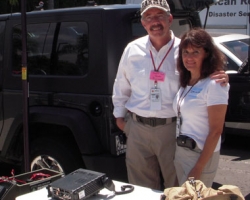The San Diego and Imperial Counties of the Red Cross and the Church of Jesus Christ of Latter Day Saints partnered on Aug. 14 to provide free hands-on shelter training for the public in Bonita.
Approximately 75 people attended the training and learned how to open and run a Red Cross shelter in case of a natural disaster.
Most of the participants were church members and learned how to perform CPR and first aid.
Red Cross volunteer Gayle Falkenthal has been a member of the San Diego Red Cross disaster team for 17 years and said that organizing a shelter teaches you how to work with residents.
“It’s very important to keep track of who’s there,” she said. Other shelter volunteers may be assigned to risk management, logistics or mental health; however, these positions require additional training or professional licenses.
Falkenthal said the LDS church does a superb job of being self-sufficient in the event of any kind of emergency,” she said. “Every individual, family, school, business and neighborhood needs to be able to be self-sustaining for 72 hours after any large disaster.”
Falkenthal was motivated to join the Red Cross when the Northridge earthquake hit in 1994.
“Society’s problems don’t get left at the door of the shelter,” Falkenthal said. “Our job is to provide a calm and safe place for people.”
One important aspect of running a shelter is providing food to those who need it. Volunteers who work in the feeding department need to be mindful of food allergies and other things that may come up.
Tom Shultz became a mass care services associate in the feeding department for the Red Cross six years ago and got involved with the organization shortly after the October 2003 fires.
“There’s got to be some way I can help people around here,” Shultz said.
The Red Cross also had ham radio demonstrations from Grady and Delora Yearwood, a husband-wife team who met in 2004 during a hurricane, and work the emergency communications for the Red Cross.
“It’s a very rewarding experience to provide emergency services to the county,” he said.
The two set up and operate in field environments using solar power as their primary source of electricity, which maintains a charge that connects to the handheld radios and helps them communicate in numerous ways during emergencies.
“Amatuer radio is a fun thing to be involved in … it’s a good way to help your community and it’s great knowledge for you to have personally, to make sure your family and home are squared away in case of a disaster,” he said.
Amateur radio is used to communicate with other radio amateurs for public services, recreation and self-training. An estimated 2 million people throughout the world are regularly involved with amateur radio.
San Marcos resident Tom Beecher heard about the event through the Community Emergency Response Team, or CERT, which he has been a member of for one year.
“CERT helped me learn more and get involved with my community,” he said.
Beecher said he came to the shelter training because public preparedness is important because you don’t have to rely on others and you are able to survive on your own.
“It’s based on the ability to prepare the family in the event of earthquakes and other natural disasters,” he said.
Sibyl Aguilar has been the emergency preparedness coordinator for the church for the last three years. Her job, which is her “calling” from the bishop, is an extremely important position as it coordinates all congregations from National City to Eastlake.
“This is the first time we’ve had the training here,” Aguilar said. “We are offering our facilities to use to help train our residents.”
Falkenthal said that being able to run a shelter facility in their own community gives the Red Cross one more resource. “These kinds of partnerships are golden to us,” she said.
Andy McKellar, director of disaster services for the San Diego/Imperial Counties chapter, talked about the importance of personal preparedness.
The training is a way to show the public what normal is suppose to look like, according to McKellar. “The first day of a shelter can be very chaotic and if you’re unprepared for that as a volunteer, it can be quite a shock,” he said.
Falkenthal said that they rely pretty heavily on mental health and social workers. “We train people as Red Cross volunteers to do all kinds of tasks that are part of responding to an emergency, natural disaster or any other emergency,” she said.
“One of the most important things we tell people on a daily basis is that you need to be ready at home in case of a disaster, be it a fire or an earthquake,” McKellar said.















